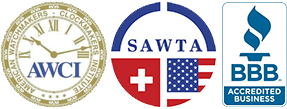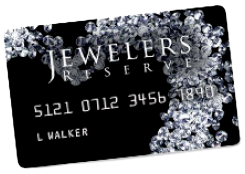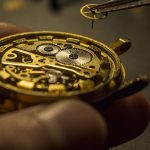Watches have existed since the early 1500s, and possibly earlier. Surprisingly, many mechanical components are still very similar to the original mechanisms. Other things have changed dramatically. A much wider variety of materials are used in watchmaking. Protective features help watches withstand potentially damaging scenarios without breaking down. Professional watch repair in Denver, CO, is even more important now than it was in the past. The vast array of materials, colors, styles, functions, and other features can be baffling without appropriate skills.
Protective Coatings
Many of us have noticed scratches on our watch clasps without quite understanding how they occurred. We don’t really expect to see scratches after working in an office or a desk at home. However, friction can cause scratches. Actions such as resting your wrist on a table or desk or moving your wrist back and forth while using a mouse. The hardness of the surface material is also a factor. Most wood surfaces aren’t hard enough to scratch a clasp or metal link during casual contact, but a little bit of friction can be a prelude to unexpected watch repairs.
Some watches have protective coatings. Specialty coatings also add shine and let the watch feel smooth against your skin. Galvanization is done by dipping the watch body into molten zinc. A thin layer of solidified zinc forms an anti-corrosive film. The necessary chemicals may be diluted before dipping steel links.
Diamond-Like Coating
Diamond-like coating, or DLC, treatments are very resilient and offer protection from friction. DLC is popular for sports watches because the coating is about 3,000 HV on the Vicker’s scale. A DLC coating also gives watches an elegant dark finish that lasts for years. Unlike some other scratch-resistant coatings, DLC isn’t prone to cracking.
Physical Vapor Deposition
PVD or Physical vapor deposition, referred to as PVD, is another coating process that fuses a thin layer of vaporized titanium to the body and bracelet of the watch using a vacuum. This titanium layer is extremely light and protects the watch body, bracelet, and clasp from scuff marks and scratches. The vacuum process binds titanium to steel watch components at very high temperatures between 212 to 680°F. PVD coatings have a stylish appearance that works well on luxury watches. Gold particles can be added through a process called PVD gilding to enhance aesthetics and add an extra protective layer. PVD coatings are normal, but they don’t last forever. Contact your local watch repair specialist to find out if your watch needs to be retouched.
Cerakote
A military-grade ceramic finish called cerakote is a good choice for protection from adverse weather conditions and rugged environments. It protects watches from abrasions, corrosion, chemical damage, and impact damage. Cerakote finishes are thicker than most other coatings and create a textured appearance. This type of coating is also customizable to match a wide range of colors and styles, which makes cerakote very popular among people with modded watches. Skilled finishers can combine colors to create unique hues and artwork. Cerakote finishes can also be removed, so you can change the appearance of your watch whenever you like.
Nanocoatings
Nano-coatings may sound futuristic and fit right into a science-fiction novel, but nanoparticles exist right now in Denver, CO. In fact, they’ve existed for a very long time. Stained glass windows from the 12th century are known for rich, vibrant glossy color. Researchers discovered that nanostructures, such as gold chloride, metal oxides, and chlorides, are responsible for long-lasting color and shine. Artisans from the 12th century didn’t know anything about nano-particles, but they developed crafting techniques to produce brilliant colors. They knew their processes worked, even if they didn’t understand it at a molecular level.
Lubricants
Friction is hard on exposed surfaces, but it can also damage moving parts inside watches. Gears and other parts are coated in lubricating oil to reduce friction. Oil will eventually degrade or congeal, and you may need a watch repair service to clean out the watch and apply new oil. Replacing degraded or congealed lubricants is a very common reason for a repair. If lubricants aren’t replaced in a timely manner, friction increases and may damage components inside your watch.
Tribologists are scientists that study friction, lubrication, and wear. Many tribologists are researching graphene and other carbon nano-particles to make low-friction surfaces. Molybdenum disulfide nanocoatings are already used in a small number of watches. The dry 1-atom thick coating is carefully applied to any surface affected by friction.
Unlike oil, nano-coatings can’t congeal or dry out. Theoretically, nano-coatings should greatly expand the interval between watch repair and cleaning appointments. Even if that’s the case, it’s still a good idea to take luxury watches to a watch repair specialist at least semi-regularly. Problems can still occur, but they may not be as obvious as congealed oil.
Corrosion
Protection from corrosion is another function of nano-coatings with an important role in watch repair and maintenance. Anti-corrosive coatings prevent contact between the underlying metal surface and a hazardous material so oxidation or other chemical processes can’t occur. Scientists are studying potential self-healing anti-corrosion nano-coatings intended to replace chromium, which is a toxic substance currently used in many industries.
Anti-corrosive coatings prevent contact between the underlying metal surface and a hazardous material so oxidation or other chemical processes can’t occur. Active protective nano-coatings are intended to detect corrosion as soon as it begins and repair the damage. Some self-healing nano-coatings are used on steel beams and ships, although it’s hard to predict when such coatings will see widespread use in watch repair.
Events in recent years led to periodic shortages of certain projects. Although high-end watches weren’t as badly affected as many other products, the demand for secondhand watches increased significantly. Product shortages of any kind are a reminder that we shouldn’t always expect to replace damaged items with new products immediately. Luckily, high-quality watches can last for a long time with proper care. Contact Matheu’s Fine Watches & Jewelry in Denver, CO, for reliable watch repair and regularly scheduled maintenance and cleaning. You can also ask about options to protect your watch and mitigate the wear and tear of daily usage.





